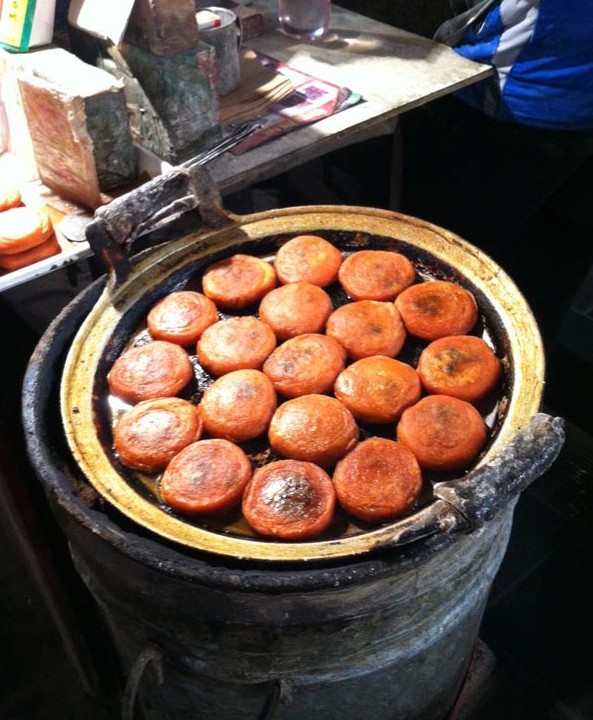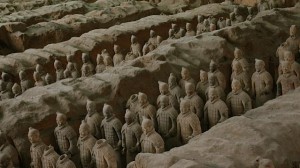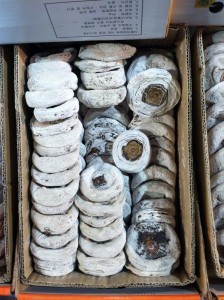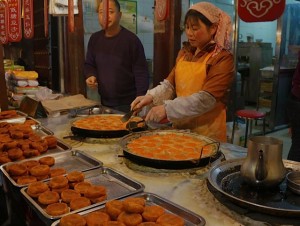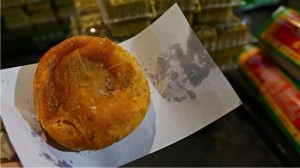By Josephine Hyde (Josephine)
Like most visitors to Xian, China, my husband and I were drawn by the prospect of visiting the site of one of the most significant archeological discoveries of the 20th century: the Terracotta Army of China’s first emperor. What we did not foresee was the remarkable variety of street food that awaited us in Xian’s Hui Muslim quarter. How were we to know that, amid the banquet before us, a humble persimmon cake fried in oil would be the one souvenir we were determined to take home?
The Terracotta Warriors Of Xi’an
Beginning in his teens, Qin Shi Huang, the first emperor of China (246-210 B.C.E.), began planning for the afterlife. It’s no wonder. The young emperor had survived coups and deflected assassins. During his reign, he subdued warring states to the south, and began a Great Wall to fend off invaders from the north. It stood to reason that he would need an army in the afterlife.
According to UNESCO’s website, Emperor Qin set 700,000 artisans to work in 246 BCE on a necropolis based on Xianyan, the imperial capital. A century later, Sima Qian wrote of this burial city in Records of the Grand Historian. He described the tomb as a microcosm of the known world, its palaces and towers set amid “a hundred rivers of mercury,” beneath “representations of all the heavenly bodies.” It’s little wonder that this story strained the limits of ancient credulity. For more than two thousand years, no one could verify the Grand Historian’s account. Then, in 1974, farmers digging a well for their orchard uncovered the first fragments of more than 8,000 terracotta soldiers.
Though Emperor Qin died prematurely after drinking an elixir of immortality, the discovery of the Terracotta Warriors has allowed him to cheat death, after a fashion. If granted a private audience with the Emperor’s ghost, I would tell him that, like millions of others, I had travelled from the other side of the world to visit his tomb. I think he would be satisfied to learn that after flying above the clouds in a giant flying chariot to reach Xi’an (something he might find astonishing), I had nevertheless felt my jaw drop at the sight of his Terracotta Army.
Visitors to the Museum of Qin Terracotta Warriors and Horses survey columns of clay figures in a hangar the size of three football fields, (a fraction of the site’s 35 square miles, mostly unexcavated). Uniform, hairstyle and stance differentiate archers, infantrymen, cavalrymen and officers. It is guidebook boilerplate that each soldier’s face is unique. As amazing as that is, I found myself pondering another tidbit offered by our official guide: the terracotta generals are not only the tallest figures, but also the stoutest. This, she explained, was due to food privileges granted by rank; rules permitted the lower ranks only a restricted diet, but officers dined better, and generals feasted. Revisionist history or fact? I have found no corroboration for the guide’s assertion, other than the satisfied expression of this high-ranking officer. Are his hands positioned to camouflage his belly?
Beiyuanmen Lu: Xi’an’s Muslim Food Street
After mulling over the culinary opportunities of the average Qin warrior, I felt lucky, as a mere civilian, to be able to sample at will the street-food banquet on Beiyuanmen Lu, in the Hui (Chinese Muslim) quarter of Xi’an. Here, we were able to eat like generals, sampling fare that Emperor Qin’s foot soldiers and archers may not have been permitted in spite of their valor and caloric requirements. These included sesame-encrusted sheep trotters, and cured meats as red as pomegranates. We abstained from these meats – not out of any sense of solidarity with the low-ranking Qin soldier – but because we were lured elsewhere by aromas of cumin-rubbed lamb kebabs and crisping chicken skin.
The typical accompaniment to the Hui mixed grill is flatbread decorated with nailhead patterns in the style of Xinjian. Curbside bakers perch above their clay ovens joking with co-workers. Every few minutes the young men deftly extract the hot breads by the very tips of yard-long skewers, twirl the loaves overhead, and deposit them with precision into symmetrical rows below.
Clay-oven bakers are not the only showmen along Beiyuanmen Lu. A local specialty of Xian is a sturdy noodle, biang biang mien. Translated as “bang bang noodles,” they are onomatopoeically named. “Bang bang” is the sound made by the dough as it hits the work table while being swung like a jump rope. The noodle cooks call out “biang biang!” to draw diners to the percussive specialty, which locals serve with a rustic tomato sauce studded with onion and celery. I couldn’t help smiling, and thinking that – like everything else – TV chef Emeril Lagasse’s “Bam!” was invented in China.
Pomegranates, dates and walnuts came to China with Islam in the 7th century, in the caravans of Silk Road traders. They remain the basis for many of Xian’s present-day sweet treats. All along Beiyuanmen Lu we saw brightly painted contraptions stirring walnuts as they roasted. Piles of dates that looked identical to us bore widely different prices, suggesting a hierarchy of deliciousness. Apparently, a good date needs little adornment – spear it with a toothpick and you are good to go. Or embed it in a rice-flour cake, for a Chinese Muslim take on clafoutis.
Simplicity is the watchword for freshly pressed pomegranate juice, but is cast aside by the vendors of a tea-based blend enhanced with apples, dried dates, goji berries, raisins and rock sugar – pure gilded lily. It might be just the thing to stand up to a snack of hot spiced peanuts, though there is nothing ancient about the chili peppers essential to much of Western Chinese cuisine. According to Shiu-ying Hu’s Food Plants of China, the capsicum, or la-jiao, arrived in China during the 17th century by way of Spain and the Philippines.
Persimmons in China
While Islam came to China in the 7th century, at least one of the foods we ate in Xian was current in the days of the Qin Dynasty: the persimmon.
Shiu-ying Hu’s book says that the persimmon (Diospyros kaki; pin yin: shi-zi) is a member of the Ebony family native to central and western China, one of the first plants to be cultivated. Hu writes that the persimmon was mentioned in one of the Five Confucian Classics, the Li Ji, the Ancient Book of Rites, for its ceremonial uses, both secular and religious. This tradition continues. Shanghai Daily reported in 2008 that newlyweds throughout China receive gifts of persimmons, seen as “lucky” because they symbolize eternal love. Botanist Hu notes that no part of the persimmon plant is wasted. The hard, dark ebony trunk makes decorative veneer, and fallen fruit, when green, makes a dye. In traditional Chinese medicine, the root, bark, calyx, flowers, leaves and fruit are used to dress burns and sores, lower blood pressure, reduce gas pains, and regulate qi.
According to Purdue University’s horticultural website, the persimmon may be eaten ripe with a spoon, or pickled in lime to acquire the texture of a crisp apple. Some persimmons get the full spa treatment. First, they sunbathe for a month or two, and receive a gentle massage every four to five days. Then they sweat under mats for 10 days (until sugar crystals form on their skins), before a gently drying in a warm breeze. Other persimmon processors choose “tough love,” exposing the fruits to near-freezing temperatures or to smoke from burning dung to stimulate ripening. Persimmons are harvested and prepared on a large scale in northern China.
In Xi’an’s Muslim quarter, amid piles of red dates and kettles of roasting walnuts, visitors will find many boxes of dried persimmons. The term shi bing, “persimmon cakes,” refers to the dried fruit. Their dark brown flesh, dusted with natural sugars from the drying process, looks frozen and hard, but they are surprisingly soft, with the texture of a prune.
The fried pastry version of persimmon cakes, shi zi bing, were at the top of my list of Xi’an specialties to seek out in the Muslim Quarter. We were acting on a tip from blogger Fiona Reilly of lifeonnanchanglu.com, who had raved that they were “. . . one of the most delicious things I’ve eaten, ever.” As a devotée of Fiona’s culinary travelogue about China, I knew that I could not miss the chance to try them.
As promised, the first taste of the warm persimmon cake was deeply comforting, and not too sweet. Frying had intensified, rather than masked, the fruit’s subtle flavor. Rosewater in the walnut filling brought out floral aromas in the first cake; sesame lent umami to the second. That pastries so humble in appearance could demand such careful consideration was a surprise, no matter the blogosphere’s rave reviews. Fillings of osmanthus, and “wuren” were difficult to identify. According to bloggers Jen and Christine of beijinghaochi.com, wuren signifies “five benevolences,” a name that seems apt for this harmonious mixture of almonds, walnuts, sesame seeds, peanuts, and sunflower seeds.
Benevolence was never a priority for China’s first emperor. Qin Shi Huang’s obsession with his own comfort and conquest in the afterlife nearly bankrupted the society that survived him, according to our guide. But his subjects’ descendants are reclaiming what is rightly theirs, since it seems the whole world has arrived in Xi’an to see the Terracotta Army. I like to think that even a ruthless emperor was not so cruel as to reserve persimmon cakes for the exclusive enjoyment of generals. Perhaps one day, when the excavation of Emperor Qin’s funerary city is complete, we will find evidence of just that. If not, I’d like to have a word with the Emperor’s ghost.


